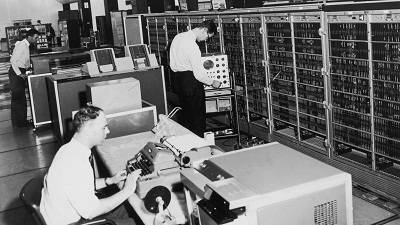Directive Blogs
When a Supercomputer is Not Enough
 We are all familiar with the black and white pictures of old warehouse-sized supercomputers. These machines are now obsolete and we have way more power today sitting on our desks. The most recent supercomputer to be disassembled due to irrelevance was not an old computer made of tubes and pulleys, but rather, it was from 2008.
We are all familiar with the black and white pictures of old warehouse-sized supercomputers. These machines are now obsolete and we have way more power today sitting on our desks. The most recent supercomputer to be disassembled due to irrelevance was not an old computer made of tubes and pulleys, but rather, it was from 2008.
What makes this piece of news even more curious is the fact that in 2009, it was touted as the world’s fastest computer. Here were are in 2013 and the world’s former #1 supercomputer is now being hauled away for scrap!
This “Supercomputer of the Year 2009” was built by IBM and given the name Roadrunner. It was designed for use at Los Alamos National Laboratory for the purpose of studying the decay of nuclear weapons. Affectionately called, “The Pride of Los Alamos,” the Roadrunner was the first supercomputer to break the Petaflop barrier and had the ability to run a simulation of the universe at a 70-billion-particle scale. The Roadrunner used 296 server racks, 122,400 processor cores, and set the US taxpayers back a cool $120 million.
What could have possibly happened in the last four-to-five years for someone to take a look at this Goliath of a machine and say, “You know what? I’m just not feeling like one quadrillion floating points per second is enough power.” It turns out the inefficiency is not due to a lack of computing power. In fact, at the time of the Roadrunner’s decommission; it was currently ranked as the world’s 22nd fastest computer. The issue of inadequacy stems from its power source.
The Roadrunner consumes so much power that the electricity bill is no longer affordable and newer supercomputers can do the same job and use dramatically less energy. Ars Technica summarizes the Roadrunner’s power shortcomings like this, “Roadrunner needs 2,345 kilowatts to run at 1.042 petaflops while a rival supercomputers needs 1,177 kilowatts and 493 kilowatts, respectively, to run at a similar speed.” The translation for all of these watts and flops means pulling the plug on Los Alamos’ pride.
While your business does not likely have a supercomputer taking up a floor in your office building, it is very likely that you are using computer hardware and software that is five years old or older. Obviously, your organization has different needs than the United States nuclear weapons program, and your current IT infrastructure may be meeting these needs just fine. Although, one lesson that we can take away from Roadrunner is that it’s always worth it to reassess your network in order to see if there is any new technology available that will improve operations.
Directive stays on top of the latest technology innovations that will improve business operations. We do this so you don’t have to. Give us a call at 607-433-2200 and we will be happy to assess your IT infrastructure and show you where dramatic improvements and upgrades can be made that will save you money. If your hardware is five years old or older, even doing little things like upgrading Ram will make a noticeable difference in performance. Although, we cannot promise that we will be able to improve your network speeds to a million, billion floating-point operations per second. That’s just crazy.


Comments